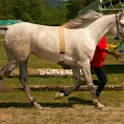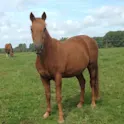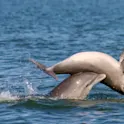1,071 news posts

Featured news
08 Apr 2021
Gut bacteria ‘talk’ to horse’s cells to improve their athletic performance
Metabolic crosstalk between gut bacteria and mitochondria during exercise of horses: Frontiers in Molecular Biosciences

Life sciences
07 Apr 2021
Study demonstrates the need to monitor the bit area of event horses
University of Helsinki A new study published in Frontiers in Veterinary Science found that event horses that wear thin or thick bits in events had a greater risk of moderate or severe oral lesions compared to horses wearing medium-sized bits, while straight bits were associated with lesions in the bars of the horse’s mouth. “Our recommendation is to use a jointed bit of moderate thickness, that is 14 to 17 millimetres, if the size of the mouth is not known, paying particular attention to the handling of mares and both warmblood and coldblood event horses. They were seen to have a greater risk of mouth lesions compared to geldings and ponies,” says doctoral student and veterinarian Kati Tuomola from the Faculty of Veterinary Medicine, University of Helsinki. “Since most mouth lesions are not evidenced as bleeding outside the mouth, the bit area should be monitored, and event organisers should carry out systematic oral inspections,” Tuomola adds. Read original article Download original article (pdf) The research group has previously investigated oral lesions in trotters. The object of the current study was event horses, that is horses which compete in events composed of three phases: show jumping, dressage and a cross-country test. […]

Featured news
07 Apr 2021
New Lyme disease test distinguishes between early and late-stage disease
Novel sensitive test for Lyme disease: Frontiers in Microbiology

Featured news
29 Mar 2021
From ghosts to evil genies: How the world experiences terrifying sleep paralysis very differently
By Colm Gorey, Frontiers science writer/Dr Baland Jalal, Harvard University and University of Cambridge Dr Baland Jalal. Image: Dr Bamo Jalal Dr Baland Jalal has spent years exploring the terrifying phenomenon known as sleep paralysis to find that the sinister entity you see at the end of your bed varies from culture to culture. Writing with Frontiers, Jalal says this has major implications for how it is experienced. Sleep paralysis is something no one will want to experience. After falling into a deep sleep, you suddenly wake up unable to move a muscle or even scream for help. To make things worse, you feel as if there is someone – or something – either sitting on top of you or looking at you from the end of the bed. While the experience will only last a short while, it can potentially have long-term implications as it might trigger a fear of falling asleep. Little is known about what exactly triggers sleep paralysis, but researchers across the world have spent much of their careers trying to better understand – and potentially manage – the phenomenon. One such researcher is Dr Baland Jalal of the Department of Psychology at Harvard University and a […]

Featured news
26 Mar 2021
What did the brains of the first land vertebrates look like?
By Mischa Dijkstra, Frontiers science writer / Dr Alice M Clement, Flinders University Dr Alice Clement. Image: Flinders University What did the brain of the early tetrapodomorphs, the first fish to develop limbs and walk on land, look like? Preserved brains are very rare in fossils, and even when preserved they were typically shrunken and deformed before becoming fossilized. For this reason, researchers mostly rely on casts of the cranial vault of fossils to study the early evolution of the brain. The closest living relatives of tetrapodomorphs, coelacanths, are known to have brains that are tiny compared to the braincase (1% of volume), so for them endocasts don’t give much information about brain morphology. But are coelacanths representative of extinct tetrapodomorphs in that regard? In a new study in Frontiers in Ecology and Evolution, Clement et al. show that this is likely not the case: among living amphibia – together with lungfish, the next closest living relatives of tetrapodomorphs – 4 basal species of frogs and caecilians have brains with a volume of 49-78% of the braincase. Their brains are somewhat larger relative to the braincase than those of lungfish, newts, and salamanders (38-47%), and the authors suggest that the […]

Neuroscience
26 Mar 2021
Learning a new language gives your brain a temporary activity boost
How do brain activity patterns change when people learn new a language? Frontiers in Behavioral Neuroscience

Neuroscience
24 Mar 2021
Study shows stronger brain activity after writing on paper than on tablet or smartphone
Unique, complex information in analog methods likely gives brain more details to trigger memory: Frontiers in Behavioral Neuroscience

Featured news
24 Mar 2021
Deforestation, forest conversion and palm oil plantations linked to disease outbreaks
Deforestation, forest conversion and palm oil plantations linked to disease outbreaks, finds new study in Frontiers in Veterinary Science

Featured news
22 Mar 2021
Having a single personal doctor may sometimes lead to unnecessary tests
Having a single personal doctor may promote overtesting for prostate cancer: Frontiers in Medicine

Featured news
19 Mar 2021
Tragedy of the Commons: The potential role of individualism in the spread of Covid-19
By Dr Yossi Maaravi, Adelson School of Entrepreneurship at IDC, Herzliya John David Photography / Shutterstock.com Dr Yossi Maaravi of the Adelson School of Entrepreneurship at IDC, Herzliya asks whether the phenomenon of social dilemmas and individualism resulted in worse outcomes for the Covid-19 pandemic? Covid-19 is a real tragedy. But why did this tragedy hit some countries harder than others? While this question has recently been answered based on population age or health policy, a few months ago, my thoughts drifted to another possible explanation: ‘The tragedy of the commons’. A few months later, these thoughts led to research that has been recently published in Frontiers in Public Health. But the story of the inspiration for this research begins many years back. 16 years ago, when I was still a PhD student, I came across Garrett Hardin’s classic article, The Tragedy of the Commons. I was fascinated by the simple yet powerful phenomenon of social dilemmas described in this article. Social dilemmas are circumstances in which certain behaviors that serve the self-interest of every individual member of society might be harmful to the common good. YESSS!!! My new @FrontiersIn article is OUT!We rely on the "The Tragedy of […]

Featured news
18 Mar 2021
Dolphins adapt to survive invasive coastal constructions
Marine ecosystems are endangered by an increasing number of coastal development projects. A new study shows for the first time that bottlenose dolphins may adapt to anthropogenic disturbance under some circumstances. The findings draw attention to the need for proper management of coastal construction sites. By Suzanna Burgelman, Frontiers Science writer Social interaction between two bottlenose dolphins. Image: Ann Waver Bottlenose dolphins learn to cope with coastal construction activities. That is the conclusion of a study published in Frontiers in Marine Science. The study is the first to provide a longitudinal perspective on the cumulative impacts of coastal construction. Dolphins adapted to the construction of a bridge by establishing feeding locations outside of the construction zone, and by shifting the timings of behaviors to a time in the day when construction activities were minimized. Coastal development practices negatively impact marine wildlife Marine coastal development is characterized by unsustainable practices. Coastal development exposes 47% of coastal marine mammal species and 51% of core marine mammal habitats to extensive anthropogenic disturbance. Human activities along coastlines and in marine habitats can lead to pollution, vessel strikes, entanglement, by-catch, and debris ingestion, which disturb and harm marine wildlife. Read original article Download original article (pdf) […]

Featured news
17 Mar 2021
Astronauts in crewed Mars missions could misread vital emotional cues
By Tania Fitzgeorge-Balfour, Frontiers science writer Long-exposure photo of the centrifuge used to simulate microgravity in the research subjects. Image: DLR Spending an extended period with reduced gravity, as would be experienced by astronauts on long space missions, may have a negative effect on cognitive performance, and in particular emotion recognition, reveals a new study. Hoping to counteract these changes, researchers found that short periods of artificial gravity did not have the desired effect. The findings of this study could have implications for effective teamwork in future space travel, especially for manned missions to Mars. Living for nearly 2 months in simulated weightlessness has a modest but widespread negative effect on cognitive performance that cannot be counteracted by short periods of artificial gravity, finds a new study published in Frontiers in Physiology. While cognitive speed on most tests initially declined but then remained unchanged over time in simulated microgravity, emotion recognition speed continued to worsen. In testing, research participants were more likely to identify facial expressions as angry and less likely as happy or neutral. ► Read original article► Download original article (pdf) “Astronauts on long space missions, very much like our research participants, will spend extended durations in microgravity, confined to […]

Featured news
15 Mar 2021
3 bacterial strains discovered on space station may help grow plants on Mars
By Colm Gorey, Frontiers science writer Interior view from the International Space Station cupola. Image: NASA Swab samples of 8 surfaces aboard the International Space Station have led to the identifying of 4 strains of bacteria, 3 of which belong to a newly discovered novel species within the genus Methylobacterium. According to researchers, these new strains might be useful in helping future space missions grow food in extreme environments. In order to withstand the rigors of space on deep-space missions, food grown outside of Earth needs a little extra help from bacteria. Now, a recent discovery aboard the International Space Station (ISS) has researchers may help create the ‘fuel’ to help plants withstand such stressful situations. Publishing their findings to Frontiers in Microbiology, researchers working with NASA described the discovery and isolation of 4 strains of bacteria belonging to the family Methylobacteriaceae from different locations aboard the ISS across two consecutive flights. While 1 strain was identified as Methylorubrum rhodesianum, the other 3 were previously undiscovered and belong to a novel species novel. The rod-shaped, motile bacteria were given the designations IF7SW-B2T, IIF1SW-B5, and IIF4SW-B5 with genetic analysis showing them to be closely related to Methylobacterium indicum. Methylobacterium species are […]

Featured news
11 Mar 2021
Could coloring our steaks blue help reduce the world’s insatiable demand for meat?
By Prof Charles Spence, University of Oxford Image: SciePro/Shutterstock Blue has become an increasingly popular color in drinks and confectionary. Now, Prof Charles Spence of the University of Oxford asks what impact tainting meat blue would have in nudging consumers toward selecting a healthier and more sustainable diet? Have you ever heard about the infamous blue steak study? According to a story that has been circulating in the academic literature for 70 years, a group of people were once invited for a dinner of steak, fries, and peas. The lighting was so dim that it was impossible for the guests to discern the food’s true color. During the meal, the lighting was returned to normal suddenly revealing that the steak had been colored blue, the peas red, and the fries green. Many of the guests apparently immediately ran off to the bathroom to be sick. While this anecdote has appeared in numerous scientific papers over the last half century, typically to illustrate the sometimes aversive influence of (blue) food coloring, it turns out that it may be nothing more than that – a mere anecdote. According to a review of blue foods that I published recently in Frontiers in Psychology, […]

Featured news
10 Mar 2021
Use of image and performance-enhancing drugs surged during Covid-19 restrictions
By The University of Hertfordshire Image: Zenza Flarini/Shutterstock 28% of people have used image and performance-enhancing drugs (IPEDs) during the Covid-19 pandemic, rising to 32% in the UK, an international study led by the University of Hertfordshire has found. Researchers say this trend is being worsened by ‘fitspirational’ posts on social media pressuring people to achieve the ‘perfect body’. Published today in Frontiers in Psychiatry, researchers asked more than 3,000 people from 7 different countries, including the UK, about their exercise habits, use of IPEDs and the feelings they have towards their appearance. ► Read original article► Download original article (pdf) They found that 32% of the UK have used IPEDs during the pandemic – 6% for the first time ever – with 43% of those buying IPEDs from the internet, likely without medical supervision or professional advice. The study also found that men were significantly more likely to use IPEDs than women, with 28% of men reporting to have used IPEDs during lockdown compared to 16% of women. IPEDs is a broad term used to capture the range of products available that can alter a person’s appearance, physical or mental performance. IPEDs can include anything from legal products such as proteins, […]